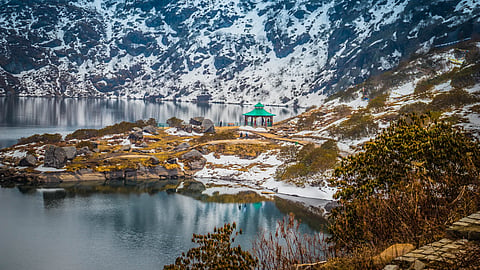
- Destinations
- Experiences
- Stay
- What's new
- Celebrating People
- Responsible Tourism
- CampaignsCampaigns
- Subscribe
- Buy Now

In a significant move aimed at modernising tourist access to its high-altitude and border-sensitive regions, the Sikkim government is preparing to roll out a fully digital system for issuing Restricted Area Permits (RAP) and Protected Area Permits (PAP). The initiative, confirmed by senior officials on November 22, marks one of the state’s most substantial administrative reforms in recent years, especially in areas where tourism and security considerations closely intersect.
Tourism Department Additional Chief Secretary C.S. Rao said the new online platform has been designed to replace the existing paper-based process entirely. Once operational, travellers visiting popular destinations such as Nathu La, Tsomgo Lake, Lachen, Lachung and Zuluk will be able to apply for permits online and receive QR-coded passes on their devices. These digital permits are expected to significantly reduce manual verification time, particularly at security checkpoints managed by police, transport authorities and defence forces.
According to officials, the shift to digital permits is intended not only to minimise long queues during peak seasons but also to ensure more efficient monitoring of visitor movement in ecologically fragile and sensitive regions. The system’s design reflects a growing demand for seamless travel experiences in the Northeast, where physical permits and long wait times have often been a deterrent for travellers.
Rao added that this digital transition is part of a broader government strategy to reduce administrative delays, improve transparency and provide “smoother, safer and more predictable travel” across Sikkim’s most visited terrain.
Parallelly, Sikkim is intensifying efforts to ensure the reopening of the critical Chungthang–Lachen axis in Mangan district by December. The corridor, vital for civilian travel, tourism and logistics, has faced closures and disruptions due to road damage, landslides and ongoing infrastructure repairs.
During a review meeting at the Tashiling Secretariat, Chief Secretary R. Telang instructed all departments and implementing agencies to work in concert to meet the December deadline.
The meeting was attended by representatives from the 27 Mountain Division, the Border Roads Organisation (BRO), the Roads & Bridges and Land Revenue departments, along with district collectors from Gangtok and Mangan.
Officials briefed the Chief Secretary on the status of road restoration efforts along the Dikchu–Mangan and Chungthang–Lachen stretches. Updates covered ongoing landslide clearance, slope stabilisation and repairs to key infrastructure damaged during the monsoon and subsequent weather-related events.
A major component of the restoration programme is the Taram Chu bridge, now in its final construction phase. Authorities confirmed that the bridge is expected to be completed by December 2025. Once finished, it will restore full connectivity along the route, easing movement for locals, the armed forces and the steady flow of tourists headed toward Lachen, Gurudongmar Lake and other northern destinations.
With both the digital permit platform and the restoration of the Chungthang–Lachen axis progressing simultaneously, Sikkim is positioning itself to provide a more streamlined and secure travel experience. For travellers, this means quicker access to permits, shorter queues, and more reliable road connectivity. For the state, it represents improved oversight and enhanced coordination across sensitive regions where tourism and security must operate in careful balance.
The coming weeks will be crucial as the state prepares for the broader rollout of the online permit system and works to meet the December reopening deadline, developments that promise to reshape the tourism landscape in one of India’s most scenic Himalayan destinations.
(With inputs from various sources.)
1. What is Sikkim’s new QR-based permit system?
Sikkim is set to launch a fully digital platform for issuing Restricted Area Permits (RAP) and Protected Area Permits (PAP), allowing travellers to apply online and receive QR-coded passes.
2. Which destinations will require the new digital permits?
High-altitude and border-sensitive locations such as Nathula Pass, Tsomgo Lake, Lachen, Lachung and Zuluk will use the new online permit system.
3. When will the QR-based permits become operational?
Trial runs are underway, and officials expect a full rollout in the coming weeks.
4. What is the status of the Chungthang–Lachen road?
The state aims to reopen the corridor by December 2025, with key restoration projects, including the Taram Chu bridge, nearing completion.
5. How will digital permits help travellers?
The system will reduce queues, speed up verification at checkpoints, improve transparency and make high-altitude travel smoother and safer.
